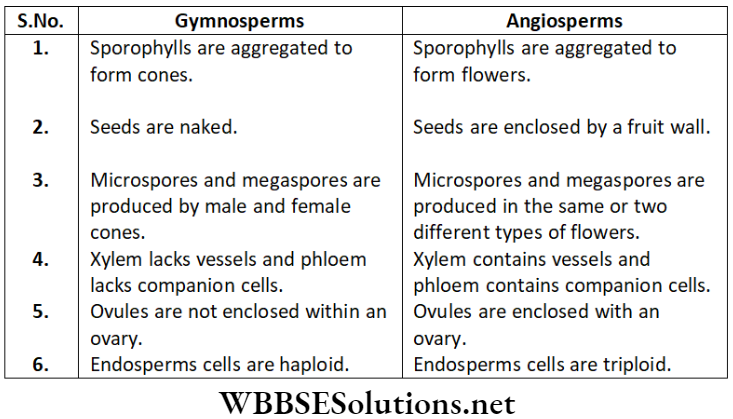Chapter 3 Diversity In Living Organisms Short Answer Type Question And Answers
Question 1. Discuss how gymnosperms and angiosperms differ from each other.
Answer.
Differences between Gymnosperms and Angiosperms


Question 2. Discuss the characteristics and features between dicotyledonae and monocotyledonae.
Answer.
Differences between Dicotyledonae and Monocotyledonae :

Question 3. Discuss the characteristics features between Amphibia and Reptilia.
Answer.
Differences between Amphibia and Reptilia:

Question 4. Discuss the characteristics features of Chordata.
Answer.
The characteristics features of Chordata:
- A dorsal, hollow, tubular nerve cord is present.
- A pliable rod known as notochord is present ventral to nerve cord and is replaced by a bone or cartilage to form a vertebral column in vertebrates. Paired gill-slits in the pharynx.
- Body is bilaterally symmetrical, triploblastic and coelomate.
- A post-anal tail is present at some stage of life.
- Segmental muscles in an unsegmented trunk. Ventral heart with dorsal and ventral blood vessels and closed blood vascular system.
- A complete digestive system is present. A cartilaginous endoskeleton is present in vertebrates.
Question 5. Discuss the features of Platyhelminthes and Nematoda.
Answer.
Difference Between Platyhelminthes and Nematoda:

Question 6. Discuss the characteristics features animal kingdom when classified on the basis of common features.
Answer.
The characteristics features animal kingdom when classified on the basis of common features:

Question 7. Describe how pteridophytes and phanerograms are different in features.
Answer.
Differences between Pteridophytes and Phanerogams (Spermatophytes):

Chapter 3 Diversity In Living Organisms Master Your Test Question And Answers
Question 1. What is taxonomy?
Answer:
Taxonomy:
Taxonomy is the scientific study of identification, nomenclature and classification of organisms.
Question 2. What is binomial nomenclature?
Answer:
Binomial Nomenclature:
The naming system where every organism’s scientific names consist of two names, where the first name is the genus to which an organism belongs and the second name is the species to which it belongs
Question 3. Why do we classify organisms?
Answer:
For easier and convenient study, we classify organisms.
Question 4. Which of the following do you think is a more basic characteristic for classifying organisms?
- The place where they live.
- The kind of cells they are made of.
Answer: Classification based on living place is more basic as there can be wide variations in organisms living in each place.
Question 5. What do you understand by the term ‘Palaeontology’?
Answer:
Palaeontology:
The study of evidences of the past life in the form of fossils. With such a large repository of organisms, it would not be easy to study every living form separately at an individual level.
Question 6. What is the primary characteristic in which the first division of organisms is made?
Answer:
Nature of cell is the primary characteristic in which the first division of organisms is decided. Based on this criterion, life forms can be classified into prokaryotes or eukaryotes.
Question 7. What is the characteristics differences between natural and artificial classification systems?
Answer:
Difference between natural and artificial classification systems:

Question 8. On what basis are plants and animals put into different categories?
Answer:
Mode of nutrition and the presence or absence of cell walls.
Question 9. What are the criteria for the five-kingdom classification?
Answer:
- The complexity of eukaryotes and prokaryotes was considered.
- Body organization was considered.
- The mode of nutrition was studied.
- The lifestyles of producers, consumers, and decomposers were considered.
- A phylogenic relationship was taken.
Question 10. What is the criterion for the classification of organisms as belonging to the kingdom Monera or Protista?
Answer:
It is the presence or absence of a well-defined nucleus. Monera has no nuclear membrane, while Protista shows well-defined nucleus.
Question 11. What are lichens?
Answer:
Lichens:
They are the association of blue-green algae and fungi living in symbiotic relationship. The algal component of the lichens is called phycobiont, whereas the fungal component is called mycobiont.
Question 12. In which kingdom will you place an organism which is single-celled, eukaryotic and photosynthetic?
Answer:
Protista.
Question 13. What is psychology?
Answer:
Phycology
The study of algae is called phycology.
Question 14. In the hierarchy of classification, which grouping will have the smallest number of organisms with a maximum of characteristics in common, and which will have the largest number of organisms?
Answer:
Organisms belonging to kingdom Monera will have a small number of organisms with a maximum of characteristics in common and kingdom Animalia will have the largest number of organisms.
Question 15. Which division among plants has the simplest organisms?
Answer:
Thallophyta or algae.
Question 16. Discuss the characteristics and features of cryptogamae and phanerogamae.
Answer:
Difference Between crypto game and Phanerogamae:

Question 17. How are pteridophytes different from the phanerogams?
Answer:
Pteridophytes have naked embryos and inconspicuous reproductive organs, whereas phanerogams have well-differentiated reproductive organs and covered embryos.
Question 18. Describe how algae and fungi are different from each other.
Answer:

Question 19. How do gymnosperms and angiosperms differ from each other?
Answer:
Seeds are naked in gymnosperms and seeds are covered in angiosperms.
Question 20. What are the amphibians of the plant kingdom?
Answer:
Small, multicellular bryophyte plants are found in shady damp places. Hence, they are also called the amphibians of the plant kingdom.
Question 21. Discuss the characteristics and features of bryophytes and pteridophytes.
Answer:
Difference Between bryophytes and pteridophytes:


